Local farmers use small-scale oil palm plantations to provide for their wellbeing, but also as a way to protect their land from wildfire
Michael Don Lopulalan
In the last decade, locals in Pulau Hanaut subdistrict, Central Kalimantan, have gradually become entangled in wildfire protection through a set of government regulations, ranging from presidential instructions, to provincial, regency, and even sub-district regulations. The Ecosystem Restoration project through PT Rimba Makmur Utama is tasked with protecting the forest area surrounding Pulau Hanaut, and invites locals to take on these responsibilities, especially when confronted by wildfires. This project has disrupted fire practices for agricultural purposes. For locals in this region the options for alternative livelihoods are limited, as is the compensation offered to them by authorities.
Since the 2010s the oil palm industry in Central Kalimantan has continued to grow, including private small-scale oil palm plantations. Local farmers are trying to participate in and understand the complexities of fire control and mitigation through their farming practices. In this way, oil palm exists not only as a provider for their livelihoods but also as a way to improve fire protection through an enhanced collective consciousness about fire. Small-scale oil palm farming has also re-instilled in these local people an affection for agricultural practices that was once lost.
Downstream on the eastern banks of the Mentaya River in Central Kalimantan, is a sub-district named Pulau Hanaut, which is made up of fourteen villages. The Banjarese are the largest ethnic group in the area, alongside others from later waves of migration. The river is the sole passage in and out.
As such, I too arrived at Pulau Hanaut by ferry. Upon landing, aside from a warning about wild alligators, I was greeted by rows of oil palm seedlings. The seedlings were growing in people’s front yards. Most houses, if not all, did the same. There were plenty of oil palms, but no obvious presence of plantation corporations. It was later that I discovered that these community small-scale plantations were a recent and growing trend triggered by a steep rise in the price of oil palm beginning in 2018.

Long before oil palm, in the New Order period, this sub-district was one of Java’s biggest suppliers of copra. Locals still have the skill to make coconut oil from scratch. They proudly recounted to me how in around 1972, the national television station TVRI recorded and broadcast images of rows of coconut trees in Pulau Hanaut. Since that time the number of trees has declined, a few blamed climate change, others blamed markets.
At around the same time, logging also expanded in the area. Legal logging turned most areas of the peatland forest into bare terrain, and the unfinished programs of the plantation forest (Hutan Tanaman Industri) deformed the landscape, leaving it abandoned and vulnerable. Illegal logging was also prevalent, before it too went into decline following incidents in Sampit in 2002, which included outbreaks of violence often simplified as ethnic conflict.
Rubber and rattan were also once sources of wealth. These commodities no longer bring enough income to meet the needs of local households. As the costs for daily staples continue to rise, the relatively unchanged prices farmers earn for their produce is a bitter pill to swallow.
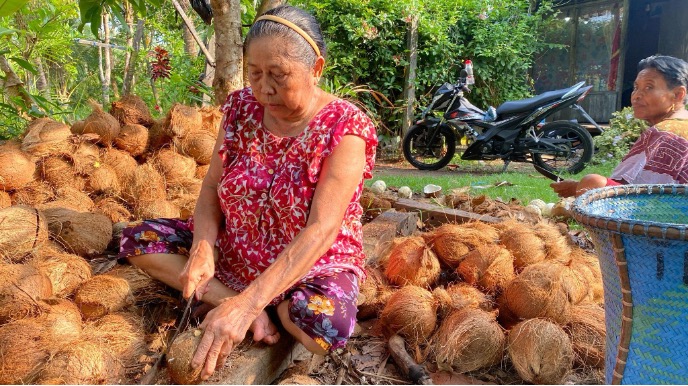
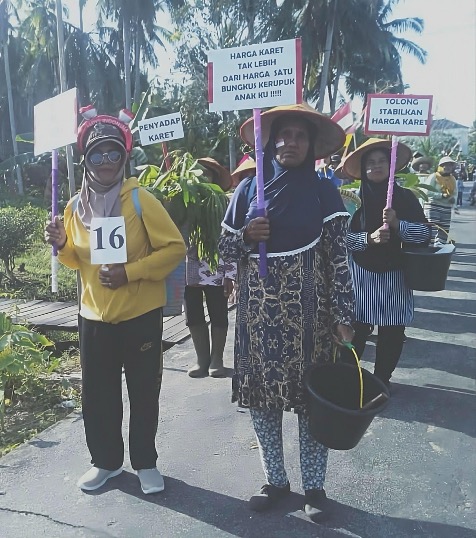
In the past, producing these various commodities and the agricultural practices used to farm them – namely subsistence rice farming on peatland – were the principal activities contributing to the needs of the household. In accordance with the wet and dry seasons the calendar is divided into different collective acts, from land clearing to harvesting. These practices are carried out in accordance with Dayak adat (tradition) and myths, combined with Banjarese Islamic influences. This method of subsistence farming meant these communities never had to worry about running low on rice and other staples. This is no longer the case.
Beginning in 2010, restrictions were introduced on the use of fire on the peatlands for any purpose, without providing many alternatives for farmers. A few years later, the ‘great’ incident of wildfire in Central Kalimantan in 2015, and the arrival of the Ecosystem Restoration project Rimba Makmur Utama in 2016, put local activity under the microscope.
The Department of Agriculture cleared plots of land for paddy fields in accordance with a program of farming that does not use burning or chemicals (Tanpa Bakar Tanpa Kimia), but the program was soon abandoned due to a lack of access to water. The restrictions on the use of fire then became an outright ban. Peatlands gradually shifted from being agricultural landscapes to political and environmental war zones.
In amongst this tangle of issues, farmers began to lose interest in cultivating paddy on their own, as they had done before. Since 2015, growing paddy has meant waiting for the arrival of wildfires, which cannot be depended on because of their randomness. Many outsiders see this approach as absurd and it is sometimes used to shape opinions and apportion blame. In the midst of this messiness another path emerged. The oil palm industries were booming and provided locals with new job opportunities. The palm oil corporation across the Mentaya River offered new hope for the people of Pulau Hanaut.



For many locals, migration from Pulau Hanaut to work on corporate plantations became an alternative to illegal mining or logging. After the 2015 wildfire burned nearby rubber and coconut plantations, some workers resorted to planting oil palm seedlings of their own. Their efforts were initially dismissed by neighbours who did not see the value in what was then a commodity with low market returns. When prices for palm oil suddenly multiplied in 2018, they joined them.
The 2019 wildfires and the establishment of Regu Siaga Api (Fire Patrol Group) and other REDD+ social projects, made locals increasingly aware of unprotected areas of land left behind by timber companies following the ‘great extractions’. This was extremely fire-prone territory. Locals began to plant oil palms in these abandoned and idle areas.
For farmers, oil palm is a single commodity with multiple benefits. First, oil palm has a better chance than others of becoming a long-lasting commodity with a stable price. They have observed up close the rapid growth of the big plantation corporations in response to increasing demand for its end products, such as oil palm for cooking. Second, small-scale plantations provide locals with decent work without the need to migrate elsewhere. Third, the young age of oil palms means that they have a good degree of resilience and resistance to fire. Even if it is burned it will regrow, sometimes even more fertile than before.

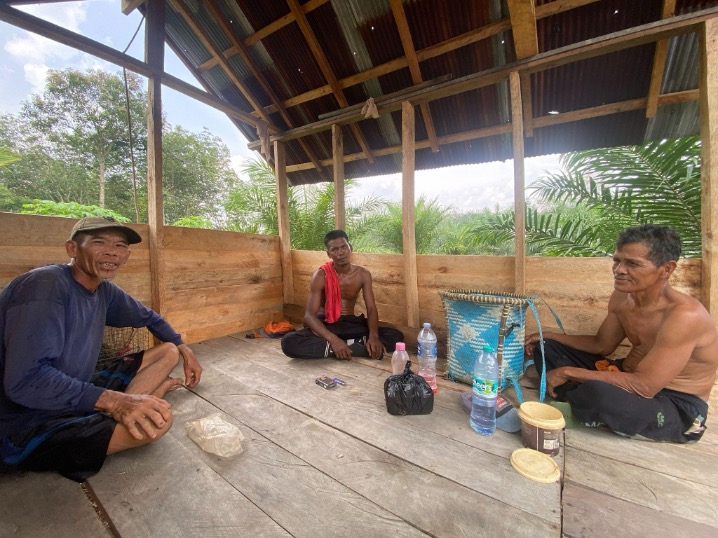
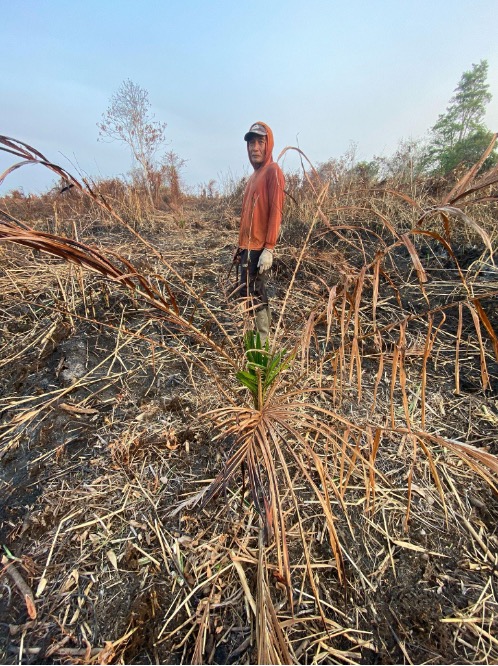
When I asked locals about the long-term impact of their oil palm production, they emphasised it as an inheritance for their children and grandchildren. From their experience working on the corporate plantations they also understood that the oil palm has a lifespan of 25 years before it needs to be replaced. They did not have a plan for what would happen after that, but for now oil palm provides a stable income every two weeks during the harvest period.
Placing oil palm as an individual and family asset also allows people to participate in fire control. Wildfire prevention has been associated with local knowledge of and practices towards fire for a long time. Oil palm provides another option in the fight to protect their assets from wildfire.
I spoke with a local man about abandoned and idle areas. He told me, ‘It would be better if all peatland areas nearby were converted to small-scale plantations.’ Through the transformation from idle to productive areas, locals could actively engage in protecting areas from fire potential, not merely stand by as spectators or even suspects.
Despite these romantic dreams most farmers still have difficulties creating productive areas for themselves. Oil palm is a needy plant in terms of water and fertiliser. It takes almost five years before the first harvest and lots of fertiliser to keep it fruitful. And that’s if there is no fire disturbance in the meantime. Whilst middle-income farmers have no difficulty growing these plants, high fertiliser prices create a significant barrier for low-income farmers, forcing them to rely on the plant’s natural growth. Land prices have also risen due to interest in oil palm from outside. Still, oil palm is an attractive long-term investment, offering some protection from the disruption caused by the frequent wildfires.
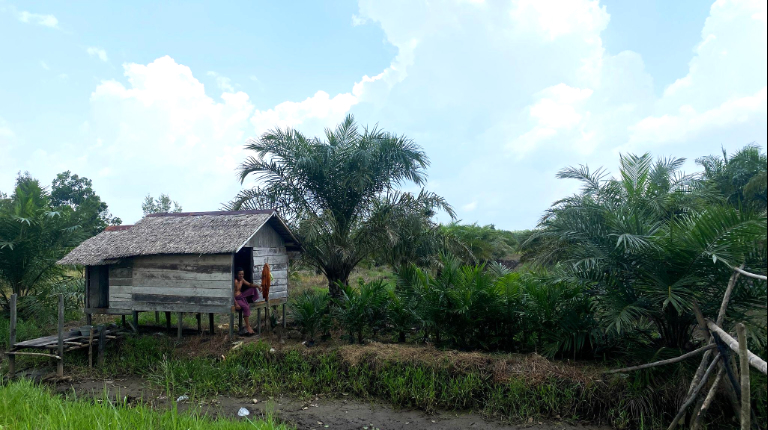
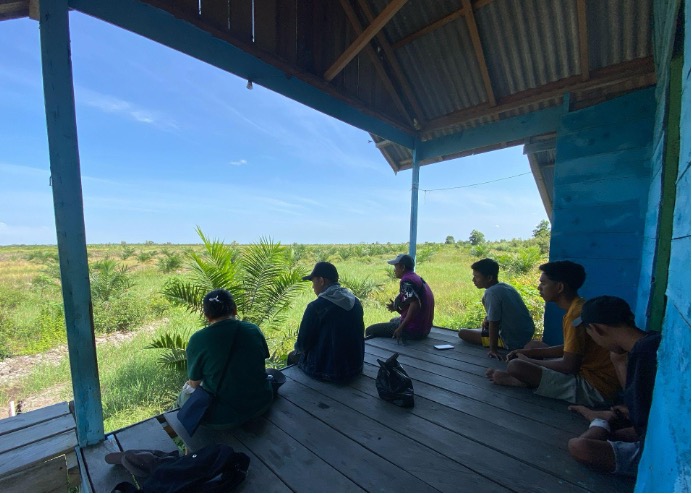

Amid debates about oil palm the people in Pulau Hanaut repositioned the plant as a temporal guide to help them navigate the labyrinth of participation in fire protection. Surrounded by uncertainties, precarity and the need to grasp the near-future for a brief moment, I recalled a passage from Plantation Life by Li and Semedi, ‘everyone sensed that something was quite wrong with plantation life, but it was a form they knew how to navigate’.
Michael Don Lopulalan (donlomichael@gmail.com) has a BA in Cultural Anthropology from Universitas Gadjah Mada. He works on various research projects focusing on livelihoods and landscapes, including the Forum Film Dokumenter developing the documentary film database, filmdokumenter.id.












